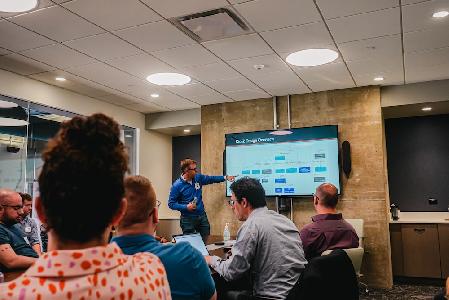This month’s Editorial Calendar is underwritten by the subject matter experts at Think Company. The stories were independently reported and not reviewed by Think Company before publication. This guest post is part of the package. Learn more about our advertising options here.
Remember when “mobile-first” was the buzzword of the day and we obsessively measured every touch target we created? We don’t hear about it today because it is ingrained in what we do. We still practice it, but it now lies in the muscle memory of experienced designers and developers. That’s where we should be with accessibility. Instead, it is often regarded as some kind of magical skill that is poorly understood and requires an expensive cleanup crew to fix.
It’s time to fix that.
I would be lying if I said Think Company had all this perfected, but we are constantly working on it. We know if we don’t, we’ll be left in the dust by someone who is. Here are a few important lessons for people in your organization.
Hey, Leaders! Good leadership is accessible
If your agency, consultancy or in-house shop is putting out work that is poorly designed or developed, the buck stops right at your desk. You have to ask yourself what you’re doing to encourage that kind of behavior. Stomping around the office taking names and venting doesn’t help, but fostering a culture of inclusivity will.
Lead your team to better decisions. Make sure everyone knows accessibility is an expectation of their work. Appoint at least one in-house expert for folks to go to when they have questions or need advice. Have that expert monitor an accessibility channel in Slack where people can discuss challenges and make better decisions.
It doesn’t stop at the work you do; think about the people doing the work. I recently attended a panel on accessibility where Neil McDevitt, executive director of the Deaf-Hearing Communication Centre, explained that hiring people with disabilities is an area of inclusivity that is often left unconsidered in the overall discussion of diversity and inclusion. (Editor’s note: Technical.ly’s recent profile of accessibility consultant Austin Seraphin echoes that sentiment.)
Much of the work Think Company does centers on the systems that people use to get their work done. Inaccessible systems limit your options when looking for talent and contribute to workplace discrimination. So stop tolerating them. Every software vendor should be able to tell you their product is fully accessible. If it isn’t, politely tell them to call back when it’s fixed.
Hey, Designers! Good design is accessible
Every project begins with defining the goals and audience for the work we are doing. It’s not good business to exclude nearly 20 percent of your user base, but designers that don’t consider accessibility do that every day.
In over 25 years of designing and building technologies, I’ve never encountered a client who has said, “Our audience is fully-sighted accountants.” That would be ludicrous. Yet your mockup with bright green and red numbers to indicate profit or loss assumes there are no color blind accountants. Inserting assumptions into a persona is bad design, but that’s what many of us are guilty of when we don’t consider the range of abilities of our audience.
Hey, Developers! Good code is accessible
Adaptive technologies rely on developers writing well-structured code that follows industry standards. So if your code is inaccessible, it’s either because you aren’t following standards, or you didn’t approach your work inclusively.
Standards ensure that adaptive technologies can interpret your work, but they also ensure that people who have limited abilities can access your work. Guess what? Accessible code just works better. For example, using anchors and form buttons instead of adding event handlers to DIVs and SPANs is helpful for assistive technologies and SEO.
Do it now
Feeling overwhelmed? It doesn’t take much to train your muscle memory:
- Study up on WCAG and 508 compliance
- Take an online accessibility course
- Attend a session on accessibility at a conference
- Attend a conference dedicated to accessibility
- Set aside an hour a week to use an assistive technology to navigate your favorite site or app
- Watch Austin Seraphin’s TED talk
Then, hold yourself accountable. Rewrite your core values. Ask whether your site has passed an accessibility audit, and ask what is being done to fix the issues found. Most importantly, accept that it is everyone’s responsibility.
Join the conversation!
Find news, events, jobs and people who share your interests on Technical.ly's open community Slack

Philly daily roundup: Student-made college cost app; Central High is robotics world champ; Internet subsidy expiration looms

Philly daily roundup: Earth Day glossary; Gen AI's energy cost; Biotech incubator in Horsham

Gain knowledge and skills at the Technical.ly Developers Conference during Philly Tech Week 2024


